Sports massage has become increasingly popular among athletes, both professional and amateur. But what is sports massage good for? This article will provide an overview of the many benefits of sports massage, including improved performance, reduced fatigue, and enhanced recovery. We will also delve into the techniques used in sports massage and the different types of massage available. Finally, we’ll discuss how to incorporate sports massage into your own training and recovery program.
Contents
What is Sports Massage?
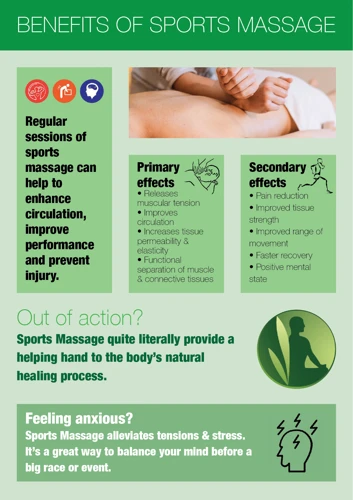
Sports massage is a form of therapeutic massage that focuses on the treatment and prevention of injuries related to physical activity. It can also be used to reduce tension, enhance performance and increase flexibility. Sports massage is often used by athletes in preparation for and recovery from physical activities, as well as for maintaining overall health and wellness. It can also be used for rehabilitation of soft tissue injuries such as muscle strains, sprains, and tendinitis.
Sports massage techniques involve a combination of manual manipulation, stretching and pressure applied to the soft tissue structures of the body. It is designed to improve circulation and reduce muscle tension, reduce inflammation, and improve range of motion. It is important to note that sports massage is not just for athletes; it can be used to treat a wide range of conditions, including chronic pain, headaches, and stress-related tension.
Why Sports Massage is Important?
Sports massage is an important part of injury prevention and recovery. It can help athletes prepare for activities and reduce the risk of injury. It can also help reduce recovery time and improve performance by loosening tight muscles, improving range of motion, and increasing circulation. Sports massage has also been shown to improve mental focus and reduce stress, ultimately resulting in improved performance.
Benefits of Sports Massage
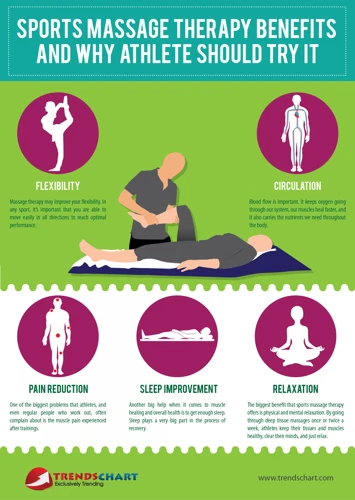
Improved Circulation
Sports massage can increase the circulation of blood and lymph, which helps to transport oxygen and nutrients to the tissues. Additionally, this can help to reduce swelling caused by inflammation, allowing for better muscle performance.
Improved Flexibility
Sports massage can help to improve flexibility by stretching the muscles and tendons, while also releasing tension and tightness in the body. This can help to reduce the risk of injury, as well as improve performance in sporting activities.
Enhanced Performance
Sports massage can help to improve the performance of athletes by helping to reduce fatigue, increase power and agility, and improve endurance. Sports massage can also help to reduce the risk of injury, allowing athletes to push themselves further.
Increased Strength
Sports massage can help to increase strength and endurance by increasing the range of motion in the joints, as well as helping to reduce muscle tension. This can help to improve overall performance and reduce the risk of injury.
Reduced Muscle Damage
Sports massage can help to reduce muscle damage by increasing the circulation of blood, which can help to reduce inflammation. This can help to reduce the amount of muscle damage caused by intense physical activity, allowing athletes to recover faster.
Improved Recovery
Sports massage can help to improve recovery by helping to reduce muscle damage, as well as reducing swelling and inflammation. This can help athletes to recover faster, allowing them to return to their sporting activities sooner.
Stress Reduction
Sports massage can help to reduce stress by releasing tension in the muscles and tendons, as well as helping to reduce inflammation. This can help to improve overall wellbeing, allowing athletes to perform better and reduce their risk of injury.
Sports massage can provide many benefits to athletes, such as improved circulation, increased flexibility and strength, enhanced performance, reduced muscle damage, improved recovery, and stress reduction. With regular sports massage, athletes can maximize their performance and reduce the risk of injury. Why sports massage? Regular sports massage can help athletes to improve their performance and reduce the risk of injury.
Why Sports Massage Is Important
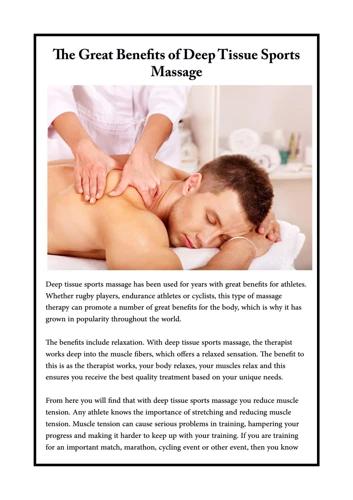
Sports massage is an effective method to relax and prepare the muscles prior to physical activity. It helps to reduce pain and stiffness, increases flexibility, improves circulation, and reduces inflammation. In addition, it can help to reduce the risk of injury by preparing the muscles for the activity ahead. By providing an overall massage, sports massage can increase performance, reduce fatigue, and improve overall health.
Sports massage is particularly beneficial for athletes because it helps to relax the muscles and improve range of motion. This can help to reduce the risk of injury, as well as improve performance. By increasing circulation, sports massage can improve recovery time after exercise and reduce soreness. It can also help to reduce the risk of overuse injuries and help athletes to stay in shape.
Sports massage can also help to reduce stress levels and improve mental performance. It can help to reduce anxiety, improve concentration and focus, and reduce mental fatigue. In addition, it can help to improve sleep quality and reduce muscle tension. Overall, sports massage helps to improve an athlete’s well-being and performance.
| Benefits | Description |
|---|---|
| Reduced Pain and Stiffness | Sports massage can help to reduce pain and stiffness in the muscles. |
| Increased Flexibility | Sports massage can help to improve range of motion, which can improve an athlete’s performance. |
| Improved Circulation | Sports massage can improve circulation, which can help to reduce soreness and improve recovery time. |
| Reduced Inflammation | Sports massage can help to reduce inflammation, which can reduce the risk of injury. |
| Stress Reduction | Sports massage can help to reduce stress, improve concentration and focus, and improve sleep quality. |
Overall, sports massage is an effective way to reduce pain and stiffness, increase flexibility, improve circulation, and reduce inflammation. It can also help to reduce stress and improve mental performance. By providing an overall massage, sports massage can help athletes to remain in shape and improve their performance.
Who Can Benefit from Sports Massage?
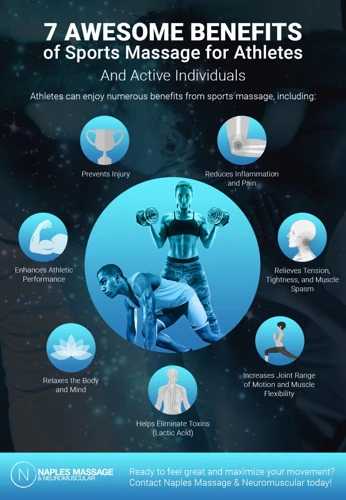
| Audience | Benefits |
|---|---|
| Athletes | Reduces muscle fatigue, increases flexibility, helps prevent injuries and speeds up recovery time. |
| Fitness Enthusiasts | Improves workout performance, reduces muscle soreness, helps prevent injuries and improves overall wellbeing. |
| Non-Athletes | Reduces stress, eases muscle tension, alleviates chronic pain and helps improve posture. |
Sports massage has many benefits and is beneficial for a variety of people. Athletes can benefit from reduced muscle fatigue, increased flexibility, injury prevention, and faster recovery times. Fitness enthusiasts can benefit from improved workout performance, reduced muscle soreness, injury prevention, and improved wellbeing. Non-athletes can benefit from reduced stress, eased muscle tension, alleviated chronic pain, and improved posture.
What to Expect from a Sports Massage?
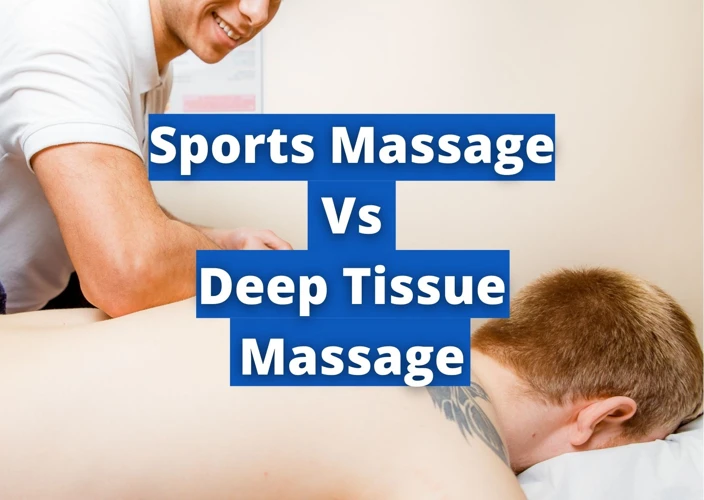
Sports Massage is a specialized form of massage that is designed to help athletes prepare for and recover from their strenuous workouts. It helps to improve circulation, reduce fatigue, and ease muscle tension. During a sports massage, the massage therapist will use a combination of pressure, kneading, and stretching to target specific muscle groups that are related to the athlete’s sport.
Benefits of Sports Massage include improved range of motion, increased flexibility, better circulation, and a decrease in muscle soreness. It can also reduce stress, improve mental focus, and help athletes stay injury free.
What to Expect During a Sports Massage
A sports massage typically lasts 30 to 60 minutes and consists of a combination of massage techniques. During the massage, the therapist will use their hands, elbows, and forearms to target specific areas of the body. They will also use oils and lotions to help reduce friction and provide a more comfortable experience.
The massage therapist will typically start with a brief discussion to determine the athlete’s needs and goals. During the massage, the therapist may use a variety of massage techniques, including long, flowing strokes, kneading, and stretching. They may also use trigger point therapy, which involves applying pressure to specific points on the body.
After the Massage
After the massage, the athlete may experience an increased range of motion, improved flexibility, and reduced muscle soreness. The athlete should also drink plenty of water to help flush out any toxins that were released during the massage.
Conclusion
Sports massage can be an effective tool for athletes who are looking to gain an edge in their sport. It can help improve circulation, reduce fatigue, and ease muscle tension. It can also reduce stress, improve mental focus, and help athletes stay injury free. Athletes should talk to their massage therapist to determine which massage techniques are best suited to their needs.
Potential Risks of Sports Massage

| Risks | Explanation |
|---|---|
| Bruising | Sports massage can cause petechiae, which are small red or purple spots on the skin caused by the rupture of tiny capillaries. |
| Skin Irritation | Sports massage can cause skin irritation, such as rashes, burns, and blisters. |
| Infection | Sports massage can introduce bacteria and viruses into the body, leading to infection. |
| Nerve Damage | Sports massage can cause nerve damage if the technique is too aggressive. |
| Fluid Retention | Sports massage can cause the body to retain fluids, leading to swelling and edema. |
Sports massage can be beneficial when performed properly, but it can also have serious risks if not done correctly. It is important to discuss any potential risks with your massage therapist before getting a sports massage.
How to Prepare for a Sports Massage?
- Shower before the massage – Taking a shower before the massage helps to loosen up the muscles and make a relaxing environment.
- Wear comfortable clothes – Wear comfortable clothes like tracksuits, shorts, or a t-shirt instead of jeans or restrictive clothing.
- Eat lightly – Eating a light meal or snack is recommended before the massage.
- Stay hydrated – Drinking water before and after the massage helps to flush out toxins from the body.
- Inform your therapist – Tell your therapist about any medical conditions, injuries, allergies, or other relevant information.
- Communicate – Let your therapist know if you are feeling uncomfortable or if the massage is too deep.
- Relax – Relax and take deep breaths during the massage and focus on the sensation of the massage.
Frequently Asked Questions
What is the difference between a regular massage and a sports massage?
- Intensity: A regular massage is typically gentler and more relaxing while a sports massage is more intense and vigorous.
- Purpose: A regular massage is generally intended to promote overall relaxation, while a sports massage is intended to address specific issues related to an athlete’s performance.
- Technique: A regular massage uses broad strokes and light to moderate pressure, while a sports massage uses more specific techniques and techniques that are more intense.
- Pressure: A regular massage typically uses light to moderate pressure, while a sports massage often uses deep, firm pressure.
Is a Sports Massage Suitable for People of All Ages and Fitness Levels?
Yes, a sports massage can be suitable for people of all ages and fitness levels. It is a massage technique that focuses on soft tissue manipulation to help improve physical performance, relieve pain, and reduce stress. It can be beneficial for athletes, fitness enthusiasts, and those who are just starting to exercise. Sports massage can help reduce muscle tension, increase flexibility, and improve circulation, among other benefits. While it is important to choose a massage therapist who is experienced and knowledgeable in sports massage, it can be beneficial for people of all ages and fitness levels.
What are the main benefits of sports massage?
Reduced Muscle Tension: Sports massage can help reduce muscle tension and stiffness, improve flexibility and range of motion, reduce pain, and improve performance.
Improved Circulation: Sports massage boosts circulation by increasing blood flow to the muscles and flushing out toxins.
Injury Prevention: By targeting specific muscles and areas, sports massage can help prevent overuse injuries and chronic pain.
Improved Recovery: Sports massage can help reduce the amount of time needed for recovery following a workout by aiding in the removal of lactic acid from the muscles.
Stress Reduction: Sports massage can help reduce stress and anxiety, improve mental clarity, and promote relaxation.
How Often Should Someone Receive a Sports Massage?
The frequency of sports massages will depend on the individual’s needs and goals. Generally, it is recommended to receive a sports massage once a month to maintain optimal performance. It can also be beneficial to receive a massage before and after a sports event or training session. Additionally, those recovering from an injury should consult a healthcare professional for advice on the frequency of sports massages.
Can a Sports Massage Help with Injury Prevention?
Sports massage is known to improve flexibility, reduce muscle tension, improve range of motion, and soothe the body. It can also help prevent injuries and improve performance by increasing blood flow and circulation to the muscles, which helps to reduce fatigue. Additionally, sports massage can be beneficial for athletes recovering from injuries by helping to reduce inflammation, restore range of motion, and reduce pain.
Conclusion
Sports massage offers a range of benefits both physically and mentally. It helps athletes in preparing for and recovering from physical activity, relieves pain and discomfort, and improves overall performance. As a result, sports massage can be used by athletes of all levels to improve their performance, prevent injuries, and speed up recovery times.
References
- Christopherson, M. (2020, November 12). Unveiling the Benefits of Sports Massage: What is Sports Massage Good For? https://www.massagemag.com/unveiling-benefits-sports-massage-good-for-82282/
- Tartakovsky, M. (2018, March 19). 10 Benefits of Sports Massage. https://psychcentral.com/lib/10-benefits-of-sports-massage/

